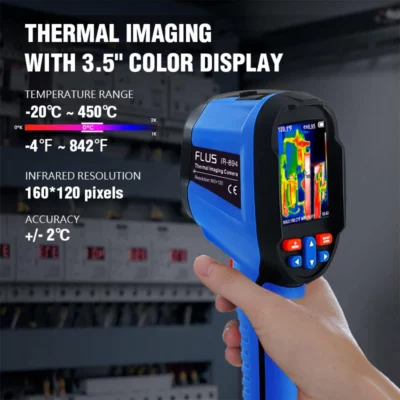Table of Contents
ToggleIn today’s world, technology has made it possible for us to see beyond the visible spectrum. One of the most fascinating tools that allow us to do this is the heat vision camera. Often referred to as a thermal camera, this device can detect infrared radiation emitted by objects and convert it into a visible image, allowing us to “see” heat. Heat vision cameras are used in a wide variety of fields, from industrial inspections to military operations and even search and rescue missions. In this blog, we’ll take a closer look at how these innovative devices work and the science behind them.
What is a Heat Vision Camera?
A heat vision camera is an imaging device that detects infrared radiation—also known as heat radiation—emitted by objects and converts this data into a visible thermal image or video. Unlike regular cameras that capture light in the visible spectrum, heat vision cameras operate by detecting thermal energy. This technology allows users to see temperature differences between objects, even in complete darkness or through obstacles like smoke and fog.
The Science Behind a Heat Vision Camera
To understand how a heat vision camera works, it’s important to grasp the concept of infrared radiation. All objects, whether hot or cold, emit infrared radiation as a function of their temperature. The hotter the object, the more infrared radiation it emits. The heat vision camera captures this radiation using sensors that are sensitive to infrared light, which has longer wavelengths than visible light.
These sensors, typically made from materials such as indium antimonide or mercury-cadmium-telluride, convert infrared radiation into electrical signals. These signals are then processed by the camera’s onboard processor and translated into a thermal image, where different temperatures are represented by different colors or shades. Warmer objects may appear in red or yellow, while cooler ones are shown in blue or purple. This color representation allows users to visualize temperature variations in real time.
Key Components of a Heat Vision Camera
- Infrared Sensors: These sensors detect infrared radiation emitted by objects. They are the most critical component of a heat vision camera, as they are responsible for converting thermal energy into electrical signals.
- Lens: The lens of a heat vision camera focuses infrared radiation onto the sensor, much like a regular camera lens focuses visible light onto a camera’s image sensor. These lenses are often made of materials like germanium or chalcogenide glass, which allow infrared light to pass through without distortion.
- Detector Array: The detector array consists of multiple sensor elements arranged in a grid. The more elements in the array, the higher the resolution of the thermal image. Higher-resolution images provide greater detail and accuracy in temperature measurements.
- Processor: After the infrared radiation is captured and converted into signals, the processor works to generate a thermal image. The processor interprets the data and assigns colors to different temperature ranges to create an easily readable thermal picture.
- Display: The processed data is then displayed on a screen, where it is presented as a thermal image. Some heat vision cameras allow the user to adjust the color palette or even overlay the thermal image on a visible image to enhance the analysis.
How is a Heat Vision Camera Used?
Heat vision cameras are employed in a wide range of applications due to their ability to detect heat differences. Below are some common uses:
Building Inspections: One of the most popular applications is in identifying energy inefficiencies in buildings. By detecting temperature differences in walls, roofs, and windows, inspectors can pinpoint areas with poor insulation or air leaks, helping homeowners or businesses reduce energy costs.
Electrical Inspections: A heat vision camera can detect overheating components or faulty connections in electrical systems. This is especially useful in industrial environments, where overheating equipment can lead to fire hazards or equipment failure.
Firefighting: Firefighters use heat-vision cameras to locate hot spots in burning buildings, detect victims trapped in smoke, and plan their escape routes. The ability to see through smoke and darkness can save lives.
Search and Rescue: In search and rescue operations, heat vision cameras can be used to locate missing persons by detecting body heat. This is especially valuable in challenging environments, such as forests, mountains, or after natural disasters.
Medical Applications: Heat vision cameras can be used to detect abnormal body temperatures or inflammation in patients. This can be useful for diagnosing conditions like infections and joint problems or even assessing the risk of fever.
Conclusion
A heat vision camera is a powerful tool that allows users to see the invisible world of infrared radiation.
0

